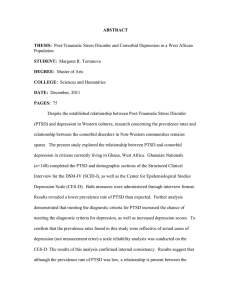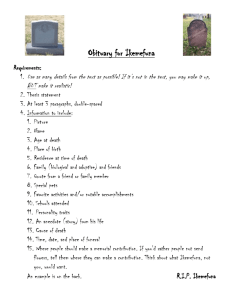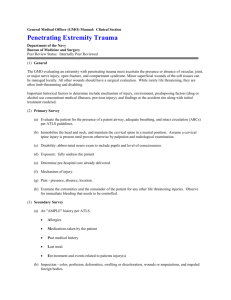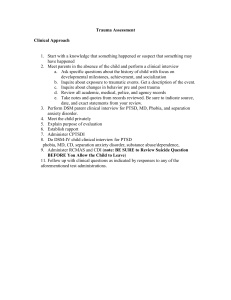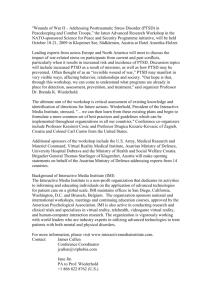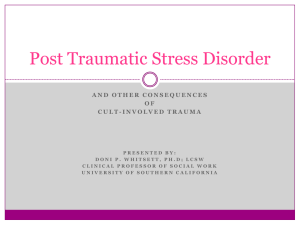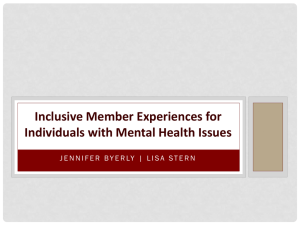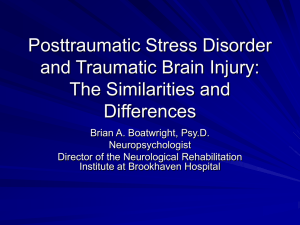When a Parent Returns with Visible or Invisible Wounds of War
advertisement
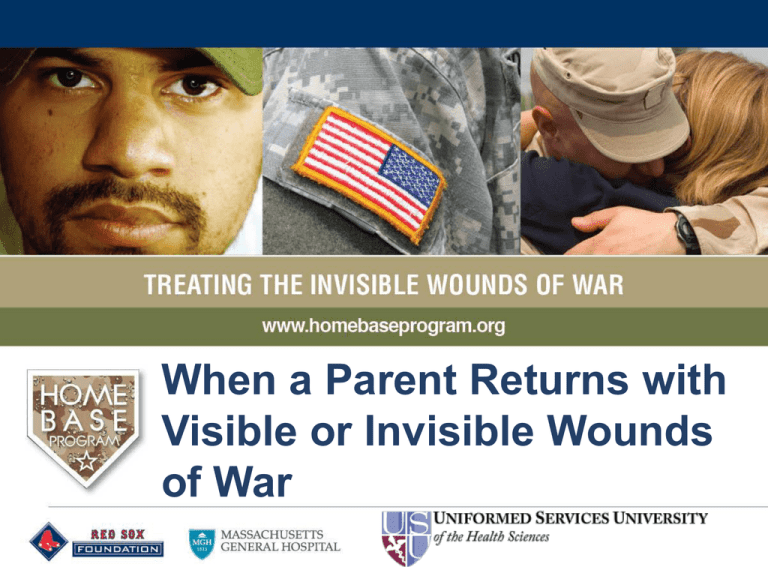
When a Parent Returns with Overseers Board Meeting Visible or Invisible Wounds December 7, 2010 of War 0 Co-Authors Allison K. Holmes Ph.D www.CIFamilies.org Research Psychologist/Project Director Uniformed Services University Paula K. Rauch M.D. www.stayingstrong.org Home Base Program, Dir. Family Program Massachusetts General Hospital Special thank you to MCEC and the Future of Children journal series Your Input • What information would be interesting and helpful to you? • What are your personal experiences— challenges and good outcomes? • What would you like the group discussion to address? – Fill out post its for collection Since 9/11 • From 2002-2010 approximately 2 million military connected children have had a parent deploy to Iraq or Afghanistan (1) • Most return affected but uninjured • “Wounds of war” – Visible – Invisible – Loss of life 1. DOD, “Report on the Impact of Deployment of Members of the Armed Forces on Their Dependent Children”, 2010 Visible Wounds • ~50,000 physical injuries (2002-2010) • Identified immediately (54% arms +legs, 29% head and neck) • Identifiable – “visible” – – – – Amputations Eye injuries Burns Spinal cord injuries • The severely injured survive more often, complex treatments • Difficult for families and children Magnitude of the Problems • Visible wounds are often accompanied by invisible wounds • About 1/3 of returning service members have TBI, PTSD, or Depression • 80% of service members with depression or PTSD at 7m. screened negative at 1m. • Emotional health impacts parenting, each family member, and family functioning • Pre existing challenges add risk Traumatic Brain Injury • • • • • Numbers are unclear (250,000-320,000+) TBI (mild, moderate, severe) Can profoundly affect parenting capacity Parent may seem like a different person Research suggests more emotional and behavioral issues in children and PTS symptoms among children • Effects very, very long-lasting Post Traumatic Stress • • • • Numbers are unclear (6-25%) Only about half seek treatment Quality treatment is often not accessible Children of parent with PTSD have higher levels of anxiety, depression, and PTSD • Younger children may be at greater risk • Dysregulation and disengagement impair parenting • Spouse emotional health is impacted Combat Related Death • 16,000 combat zone deaths (includes the 14% self inflicted/suicide in theater) • Limited research • Surviving spouse’s emotional health key • Pride in service and community recognition may support resilience • Loss of social connections associated with dislocation is a stressor • Military provides special supports Four Stages of Recovery • Acute Care • Medical Stabilization (1/4-1/3 involve a family member relocating) • Transition to Outpatient Care • Long Term Rehabilitation and Recovery – Family Impact – Child’s Experience 9 Child’s Perspective • Getting bad and often confusing news • Long hospitalization with disruptions at home (co parent may be absent or child may move) • Discharged from the hospital, but not home yet (often many re hospitalizations and set backs) • Living with a new normal (difficult) Seeing and Hearing • How do I understand the mood at my home? • Who is talking to me? Do they care about my experience? • How is my routine changed? • When will things go back to “normal”? • Adjusting to a new normal…is this forever? A Child’s View of a Good Parent • • • • • Good parents are calm Good parents are predictable Good parents remember things Good parents enjoy being with you Good parents don’t name call – Substance use, PTSD, depression and head injuries can interfere with the above and can leave a child feeling unloved – Co-parent health and well being is key 12 Development is like a long hike up a series of hills Resilience Support (PACT Model) Family Community Developmental Stage Challenge Temperament Preventing Transgenerational Trauma • Challenge: Difficult situation without a quick fix – Faced with the support of connected caring others – Builds important life skills – Results in greater self confidence and courage • Traumas: Difficult situation without a quick fix/escape – Surprise or out of control feeling – Faced feeling alone, isolated and helpless – Results in greater fear and insecurity 15 3 Generational Care • Complicated deployment impacts the whole family – Identification – Service member support – Family members with primary mental health and instrumental needs • Resilience support and care must be family centered • National and local community commitment Recommendations: Long Term • We need to know more • Supports through recovery or bereavement must be family focused • Non service member parents and children need access to long term mental health care: “service connected family” • Community providers need education about military family needs • Program development & evaluation essential
